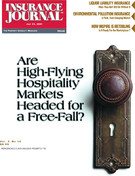A recent study by Palm Beach Gardens, Fla.-based Weiss Ratings Inc. indicated that just eight large property and casualty insurers provide homeowners coverage to residents in hurricane-prone states. Weiss Ratings, a provider of independent insurance company ratings and analyses, said that in 2000, eight carriers commanded 81.4 percent in Texas, 50.4 percent of the market in Florida, 57.5 percent in North Carolina, 62.3 percent in South Carolina and 64.1 percent in Louisiana.
Those eight companies are State Farm, Allstate, Zurich Financial Services Group, Nationwide Group, Citigroup, USAA Group, Safeco and Liberty Mutual. The study revealed that two companies – State Farm and Allstate – controlled 39.8 percent of the total market share in the hurricane-prone states last year. They also shared market dominance in Florida by holding one-third of all policies in that state.
Weiss indicated that the concentration of policies in so few carriers is cause for concern. The company cited events in the wake of Hurricane Andrew in South Florida when insurers claimed it was unreasonable for them to be expected to cover risks of such magnitude and ceased writing new business. Already this year, $2 billion in damages have been recorded in Texas and Louisiana as a result of Tropical Storm Allison, and 11 more named storms are predicted for the remainder of 2001. Last year, Zurich had the most exposure, with 36 percent of its total homeowners policies in the five hurricane-prone states. Among the remaining seven insurers, the exposure ranged from 11 percent for Safeco to 32.7 percent for USAA.
The growing concentration of the homeowners insurance market is a national phenomenon that has been progressing for many years. At year-end 2000, the same eight insurers controlled a record 58 percent of the market, compared to only 26 percent in 1965. State Farm and Allstate have increased their market penetration even more dramatically, increasing their combined share of the national market from six percent in 1965 to 33.3 percent in 2000.
According to Weiss, the nation’s property and casualty insurers, covering more than 30 lines of business, saw profits decline 55 percent in three, from $59.1 billion in 1997 to $26.7 billion in 2000. This drop was caused by a combination of increased underwriting losses and decreased investment income, which is typically used by insurers to offset underwriting losses.
During a three-year period that coincided with the hardening of the underwriting cycle, which occurs as insurers raise rates in response to mounting losses, insurers’ underwriting losses climbed from $875 million in 1997- the lowest level in 10 years – to $27 billion in 2000. The companies that experienced the largest decline in underwriting earnings from 1997 to 2000 were: State Farm Mutual Automobile Insurance Company (Ill.), with a decline of $4.7 billion; State Farm Fire and Casualty Company (Ill.), with $1.4 billion in lower earings; Allstate Insurance Company (Ill.) with a $908 million decline; and United Services Auto Association (Texas), declining $817 million.
Among the 2,478 property and casualty insurers recently reviewed by Weiss, 107 received upgrades, while 147 were downgraded.
Weiss issues safety ratings on more than 15,000 financial institutions, including property/casualty insurers, HMOs, life and health insurers, Blue Cross Blue Shield plans, banks, and brokers. Weiss also rates the risk-adjusted performance of more than 11,000 mutual funds. Weiss receives no compensation from the companies it rates, deriving revenues from sales of its products to consumers, businesses, and libraries.
Topics Florida Catastrophe Carriers Natural Disasters Texas Hurricane Property Casualty Casualty
Was this article valuable?
Here are more articles you may enjoy.


 North Carolina Adjuster and Son Charged With Embezzlement in Roof Jobs
North Carolina Adjuster and Son Charged With Embezzlement in Roof Jobs  USAA to Lay Off 220 Employees
USAA to Lay Off 220 Employees  Grand Jury Indicts ‘Hole in Won’ Owner on Prize Insurance Fraud Charges
Grand Jury Indicts ‘Hole in Won’ Owner on Prize Insurance Fraud Charges  California Sees Two More Property Insurers Withdraw From Market
California Sees Two More Property Insurers Withdraw From Market 


